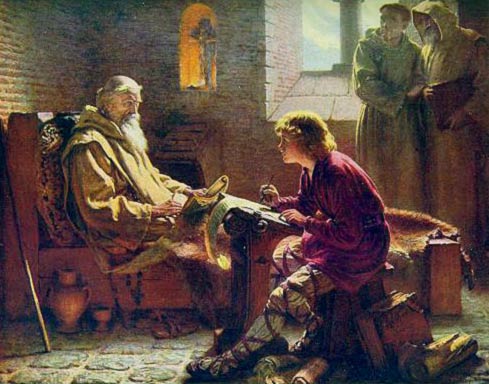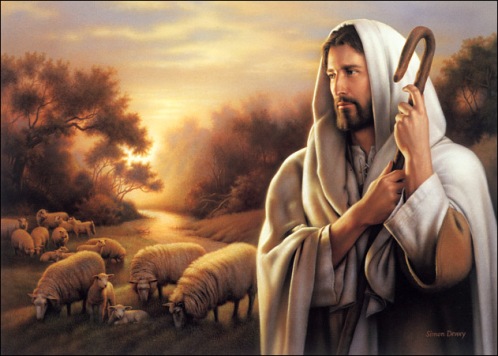RESOURCES
5-144000
A
B
C
D
E
F
G
H
I
J
K
L
M
N
O
P
Q
R
S
T
U
V
W
Y
Z
|
|

 5
JOHANNINE ESSAYS
5
JOHANNINE ESSAYS
 The Doctrine of the Shepherd
(25 October 1982)
The Doctrine of the Shepherd
(25 October 1982)
by Christopher C. Warren, M.A.(Oxon)

Intro | 1 | 2 | 3 | 4 | 5 | 6 | 7 | 8 | 9 | 10 | 11
12 | 13 | 14 | 15 | 16 | 17 | 18 | 19 | 20 | 21
A key to an understanding of the concept of the Shepherd in chapter 10 of John's Gospel lies in the realisation that the discourse is spoken to the Pharisees. The purpose of the discourse is to contrast the relationship between the Pharisees and the people with the relationship between Yah'shua (Jesus) and the believers. The Pharisees are those who do not enter by the door; they are thieves and robbers, strangers, hirelings: Yah'shua (Jesus) is the one who enters by the door, the shepherd, and the door to the shepherd. Yah'shua's (Jesus') authority is like that of the sheep-owner, and it is recognised as such by those who belong to Him, and the purpose for which He uses it is the welfare of the sheep, for whom He will soon lay down His life.
It has been suggested by various authorities that the discourse of the Shepherd is drawn in part from the Old Testament. The prophet Ezekiel received a prophecy from Yahweh concerning the shepherds of Israel who were then the religious leaders of the nation (see Ezek.34). These men were condemned for looking after their own carnal interests at the expense of the spiritual welfare of the Israelites, just as Yah'shua (Jesus) condemned these latter-day religious leaders, the Pharisees, in John's account. In Ezekiel, Yahweh-Elohim, the Lord God of Israel, is the true Shepherd who seeks out the sheep scattered abroad by the darkness promulgated by the wicked religious leaders. Now Yah'shua (Jesus) is the true Shepherd, the representitive of the Father, and perhaps even the Elohim (God) of Israel Himself. Thus it could justifiably be claimed that the discourse of the Shepherd was another of Yah'shua's (Jesus') ways of claiming His divinity, and if this is so, John's account takes on added significance.

It has also been suggested that John's Shepherd Account owes part of its background to the Synoptists (Mark and Luke), that it is the wreckage of two parables fused in one, the fusion having partly destroyed the original form of both. I find the Ezekiel background the more convincing for this prophecy would have been known to the Jews and therefore its use by Yah'shua (Jesus) would have been consistent with the way in which He drew from tradition and the Law (Torah) to illustrate His message. The Jews were, after all, originally, and still to a large extent then, herders of sheep. The early Patriarchs had all been nomads accustomed to the ways of the sheep-herder. The head of the family (the patriarch) would personally lead his sheep from pasture to pasture, and the sheep would follow him, as they still do in eastern countries. Yah'shua (Jesus), in His allegory, typifies this eastern tradition. He is the Shepherd of the souls of men, and as the True Shepherd of Heaven, is recognised by His sheep who follow Him wherever He goes. The disciples cleave to His light - the truth He speaks and the Ruach haQodesh (Holy Spirit) that He possesses - like the sheep follow their master's voice, a voice so distinctive that no hireling can imitate it. The True Shepherd takes the greatest trouble over the welfare of His sheep, leading them not by force, but by drawing them - He is their father in that He has reared them, fought for them, protected them, and cared for them. Yah'shua (Jesus) contrasts the true Shepherd with the hireling whose interests are selfish, like the Pharisees'; the hireling is not recognised by the sheep and cannot draw them by passive means. He obtains, like the Pharisees, what he wants by force, and when he has plundered, departs to leave the sheep to perish. The Pharisees have robbed the Jewish people of spiritual truth, blinded them respecting the identity of the true Messiah, and taught them to seek after carnal things rather than the spiritual, keeping them in check and under their control by stringent legalities. But when even their restrictive measures fail, they will abandon the Jews to the wolves from Rome who scatter them until once again, in the meridian of time, they come to recognise Yah'shua (Jesus) as their true Shepherd and are once more gathered in peace and security. In the meantime Yah'shua (Jesus) sends His disciples to other folds, the gentiles, to gather them in. Though blinded by their own hirelings, they have not the historical distortion of the Pharisees behind them.
Sheep figure a great deal in Jewish teaching. They are harmless animals but suffer from a lack of initiative amounting to weakness so that, like many human beings, they are easily lost or led astray. Without a Shepherd, it is a helpless creature. Yahweh's human servants are very frequently likened to sheep in the Old Testament, an idea so well elaborated in John 10 and Isaiah 53 where in the Messianic tradition the Saviour is likened to an innocent sheep being taken to the slaughterer's. The allegory of sheep and shepherd was therefore not foreign to the Jews who must have known exactly what Yah'shua (Jesus) was talking about when He spoke from their cultural milieu.
Intro | 1 | 2 | 3 | 4 | 5 | 6 | 7 | 8 | 9 | 10 | 11
12 | 13 | 14 | 15 | 16 | 17 | 18 | 19 | 20 | 21


This page was created on 6 February 2004
Updated on 6 February 2004
Copyright © 1987-2008 NCCG - All Rights Reserved

|
|


